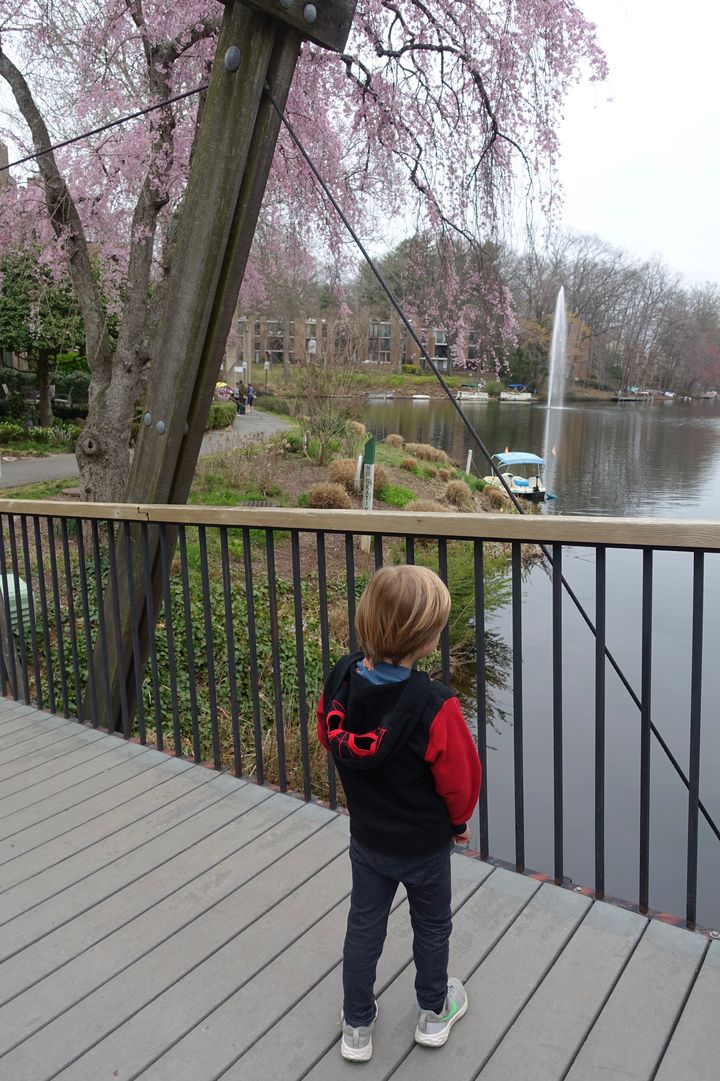
My 4-year-old son has five health conditions, including imperforate anus (being born without an anus). His body is so unique that there may only be a handful of people in the world with his exact combination.
So when he turned to me one day and said, “I wish you had an ostomy bag too,” I could hear in his wish how alone he felt.
I didn’t want him to feel alone, so I went into our bathroom, where I pile stacks of medical supplies. I took out an ostomy bag, which is similar in size to a sandwich baggie and into which he stools through a hole in his abdomen, and taped it to my stomach. I thought, hey, friends and family of people losing their hair due to chemotherapy shave their heads in solidarity — so if it helps him, I will wear an ostomy bag every day.
When he saw the bag on me, he excitedly asked: “Wait, you have an ostomy bag too? You will poop there too?”
I didn’t want to lie or discount the major surgery his small body had endured to create his stoma. I said: “No, baby, I taped mine on, see? But I will do this if it helps you feel less alone.”
Crestfallen, he said no, he didn’t want me to tape one on. And then I felt foolish for thinking that doing so would be helpful for him. While his dad and I do everything we can to care for him, advocate for him, and help him live a full life, our bodies are different from his, and they always will be.
There’s no doubt that many children with disabilities feel alone or noticeably different every day. They may be the only person with disabilities in their family, their neighborhood or their school. While the Centers for Disease Control and Prevention says up to 27% of U.S. adults have a disability, the Census Bureau reports that only 4.3% of children have one. The most common type among children are cognitive disabilities, which my son does not have.
Additionally, most children will see very little representation of disabilities in the world. For instance, a 2022 study found that in the previous year there were no lead characters with disabilities in popular programming for children ages 2 to 11. Among notable supporting characters, 0.5% had a disability.
An analysis of Disney and Pixar films from 2008 to 2018, meanwhile, showed that when a character had a disability, it was usually to elicit pity or humor, or to show that the character was old or evil.
Most toys and books for children do not depict or incorporate disabilities, though there are a growing number of people working to change this. For instance, here are 11 toys that incorporate disability and 20 books about disability.
We need more content and toys like this so that children with disabilities see themselves, and so that all kids can better understand, appreciate and accept the range of bodies in our world.
In the meantime, while I can’t make people who have the same disabilities as my son appear in person or in the shows he watches or the books he reads, I can work harder to help him feel seen and understood. I never want to ignore or hide his disabilities, as they are part of who he is and he should never feel ashamed about them.
For instance, during this past preschool year, my son said to me a few times that he wished his friends understood his body. A therapist we’d taken him to told us that it was important to let him talk about his surgeries, medical experiences and physical differences to help him address and process his medical traumas. So I asked my son if he’d like me to ask his teachers about doing a presentation to his class to help them understand him more, and he said yes. His teachers agreed.
One January day, I stayed after preschool drop-off and joined his class for circle time. He and I sat in the front, and I talked about how bodies can be different — people have different eye colors, skin colors, hair textures and heights. We explained how some people use sign language, wear glasses or use wheelchairs.
Then I told the class that my son was different in how he goes to the bathroom. Using a special doll that he was given at the hospital after his ostomy surgery the year before, I showed them where an ostomy bag goes and how it works. My son happily passed around catheters — he has a neurogenic bladder, and we use catheters to empty his bladder every 3 to 4 hours — as well as ostomy bags for his friends to examine.
The kids listened intently to everything we said. Several children nodded when I talked about how all bodies are different, and they all carefully examined the medical supplies. Near the end, when I asked my son if he had anything else to add, he whispered that he “goes to the doctor a lot.” I repeated louder what he had said and asked his classmates if they had ever been to the doctor. This was something to which they could relate, and they were full of stories about their experiences at the doctor’s office.
Being open about differences is a tactic I saw my parents employ for my sister Heidi, who had microcephaly and cerebral palsy-like symptoms. She could not walk, talk or hear. And she could not swallow food, so she had a feeding tube and drooled. People who did not know her would often stare at the playground or swimming pool. They weren’t used to seeing someone like her and weren’t sure what to think.
We moved every few years for my dad’s job, and my parents — and then I, as I grew older — always made a point to explain Heidi and her differences to our neighbors, as well as to people at school and at our church.
I remember watching a gaggle of girls clamber around her at recess and lunch at our elementary school to play with her and help her. In our neighborhood in Kentucky, where we lived for a few years, kids learned a handful of sign language words to help communicate with her. We also included her in our neighborhood games, like kickball — our mom helped her push the ball off her tray, and she drove her wheelchair to the bases.
Once people better understood what was different about her, they quickly came to accept and love her.
When I arrived back at my son’s preschool class after lunch to do his midday catheter and ostomy bag care, I asked how he felt after telling his friends about his body. “I loved doing it,” he said. “I’m happy that my friends got to see how I work.”
July is Disability Pride Month, and it’s a good time to remember the importance of talking openly about our differences. It’s up to the adults in the lives of children with disabilities to help them feel seen, accepted and loved.
Holly Kearl is an author, a community manager at the Aspen Institute, and the founder of Stop Street Harassment.
Do you have a compelling personal story you’d like to see published on HuffPost? Find out what we’re looking for here and send us a pitch.
